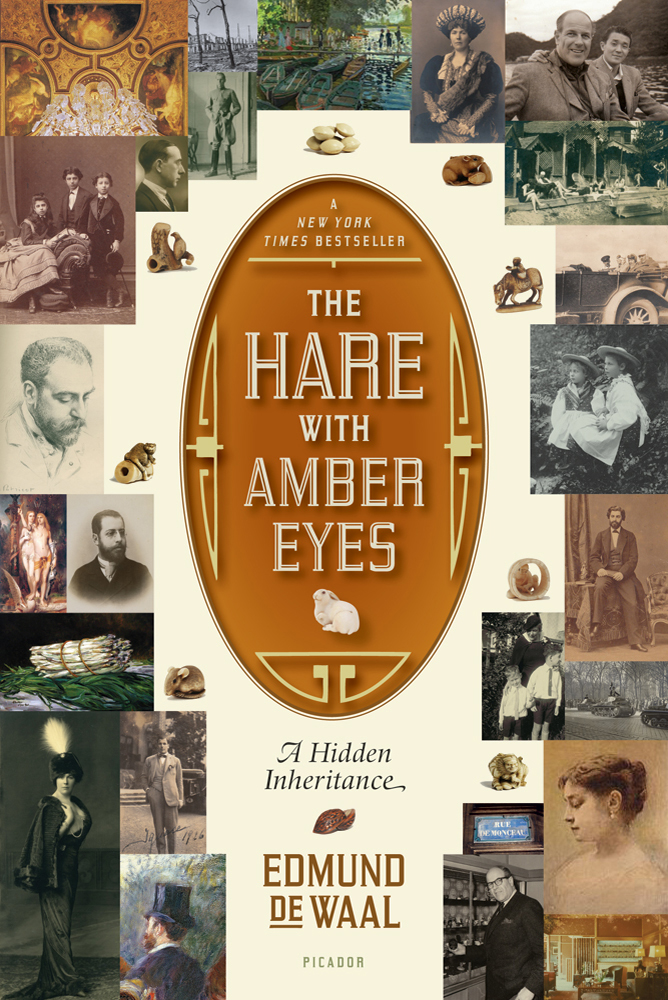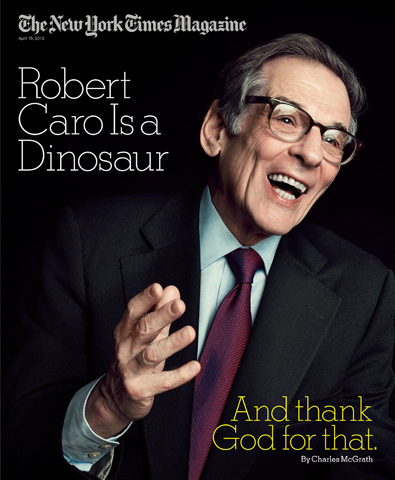 One of the many pleasures of Edmund de Waal’s The Hare with Amber Eyes: A Hidden Inheritance (2010) is its evocation of the thrill of research. As he traces the history of his family’s netsuke (small Japanese ivory and wood carvings), de Waal describes great-great-great grandfather Charles Ephrussi’s art-collecting in nineteenth-century Paris as “‘vagabonding’ … done with real intensity”:
One of the many pleasures of Edmund de Waal’s The Hare with Amber Eyes: A Hidden Inheritance (2010) is its evocation of the thrill of research. As he traces the history of his family’s netsuke (small Japanese ivory and wood carvings), de Waal describes great-great-great grandfather Charles Ephrussi’s art-collecting in nineteenth-century Paris as “‘vagabonding’ … done with real intensity”:
Vagabonding was his word. It sounds recreational rather than diligent or professional…. But it does get the pleasure of the searching right, the way you lose your sense of time when you are researching, are pulled on by whims as much as by intent. It makes me think of the rummaging that I am doing through his life as I track the netsuke, the noting of other people’s annotations in the margins. I vagabond in libraries, trace where he went and why. I follow the leads of whom he knew, whom he wrote about, whose pictures he bought. In Paris I go and stand outside his old offices in the rue Favart in the summer rain like some sad art-historical gumshoe and wait to see who comes out. (72-73)
That’s exactly right. Writing a biography – or, truly, intense research of any kind – is detective work. It’s extremely absorbing, getting a lead, following it to a new source, finding connections between lives and ideas. You are on a quest, and you must keep going until you finish!
 But dedication to the quest also takes its toll. As Charles McGrath reports in today’s New York Times Magazine profile of master biographer Robert Caro, researching and writing the third volume of The Years of Lyndon Johnson had taken so long that Caro and his wife went broke. She sold their Long Island home, found them a cheaper apartment in the Bronx, and got a teaching job to help pay the bills. The biographer – obsessive, driven, seeking every last detail – often depends upon a patient, supportive spouse. It’s no coincidence that my forthcoming biography, Crockett Johnson and Ruth Krauss: How an Unlikely Couple Found Love, Dodged the FBI, and Transformed Children’s Literature, is dedicated to Karin. Who else but one’s partner would put up with such fanatical devotion to a book?
But dedication to the quest also takes its toll. As Charles McGrath reports in today’s New York Times Magazine profile of master biographer Robert Caro, researching and writing the third volume of The Years of Lyndon Johnson had taken so long that Caro and his wife went broke. She sold their Long Island home, found them a cheaper apartment in the Bronx, and got a teaching job to help pay the bills. The biographer – obsessive, driven, seeking every last detail – often depends upon a patient, supportive spouse. It’s no coincidence that my forthcoming biography, Crockett Johnson and Ruth Krauss: How an Unlikely Couple Found Love, Dodged the FBI, and Transformed Children’s Literature, is dedicated to Karin. Who else but one’s partner would put up with such fanatical devotion to a book?
This process recalls a line in a recent Times Higher Education piece on academics: “the idealised academic has no ties or responsibilities to limit their capacity to work.” This is equally true of the biographer. For both the professor and the biographer, there is no boundary between life and work. Your life is your work and your work is your life. Or, in the case of the biographer, your work is someone else’s life.
I’m not arguing that one’s work should be all-consuming, though I would note that Caro’s work on LBJ and Edmund de Waal’s absorbing family history are both excellent because each writer is so very thorough, obsessive, and meticulous – in both the research and the writing. McGrath notes that Caro and his editor Robert Gottlieb “argue about length, but they also argue about prose, even about punctuation.” As Gottlieb says,
You know that insane old expression, “The quality of his defect is the defect of his quality,” or something like that? That’s really true of Bob [Caro]. What makes him such a genius of research and reliability is that everything is of exactly the same importance to him. The smallest thing is as consequential as the biggest. A semicolon matters as much as, I don’t know, whether Johnson was gay.
Beyond providing a helpful context for my own battles with Walter (my editor for the bio), this explains my own process to me. It’s not just about perfectionism. It’s about getting it right. And everything matters: Structure, word choice, punctuation, which detail gets retained and which one gets cut.
Caro had to cut 350,000 words from The Power Broker: Robert Moses and the Fall of New York. He tells McGrath sadly, “There were things cut out of ‘The Power Broker’ that should not have been cut out,” and then shows him “his personal copy of the book, dog-eared and broken-backed, filled with underlining and corrections written in between the lines. Caro is a little like Balzac, who kept fussing over his books even after they were published.” It would be an understatement to say I can relate to that. Though I had to cut far fewer words from my biography of Crockett Johnson and Ruth Krauss, there were things cut that should not have been cut. And I’ve seriously thought of marking up a published copy (due this September) to fix those omissions, or infelicitous changes in phrasing introduced during the copyediting (the copyeditor was unusually fond of passive voice). In looking at the proofs, I thought: Why did I allow the excision of Johnson’s favorite book, George and Weedon Grossmith’s The Diary of a Nobody? My main reason was (and is) the fact that I can include it – and its satirical style’s influence on Johnson – in one of the afterwords for the 5-volume The Complete Barnaby. It’s hard to let this go, and I’m fortunate to have the luxury to hang on a bit longer. As de Waal writes near the end of his book, he has the feeling that he should “Just go home and leave these stories be. But leaving be is hard” (346).
Most of all, when reading Caro or de Waal, I think: my God, I wish I could write like them! I’m not in their league. Indeed, my league couldn’t find their league on a map. Describing the motorcade in Dallas on 22 November 1963, Caro writes,
Lyndon Johnson was far enough behind the Presidential limousine that the cheering for the Kennedys and the Connallys – for John Connally, some of it, for his onetime assistant, who had become his rival in Texas – was dying down by the time his car passed, and most of the faces in the crowd were still turned to follow the Presidential car as it drove away from them. So that, as Lyndon Johnson’s car made its slow way down the canyon, what lay ahead of him in that motorcade could, in a way, have been seen by someone observing his life as a foretaste of what might lie ahead if he remained Vice-President: five years of trailing behind another man, humiliated, almost ignored, and powerless. The Vice-Presidency, “filled with trips . . . chauffeurs, men saluting, people clapping . . . in the end it is nothing,” as he later put it. (“The Transition,” The New Yorker, 2 Apr. 2012, 35-36)
Masterful. I favor tighter sentences myself, but his epic style works well with his subject. We readers know that, in a few moments, President Kennedy will be assassinated; later that day, LBJ will become president. And Caro knows we know. So, he allows our knowledge to inform the scene, and instead focuses on creating Johnson’s (likely) experience at that moment – enduring the relative powerlessness of the Vice-Presidency.
De Waal writes lyrically and with great insight into what it means to be human. Early in the book, he observes, “Melancholy, I think, is a sort of default vagueness, a get-out clause, a smothering lack of focus. And this netsuke is a small, tough explosion of exactitude. It deserves this kind of exactitude in return” (16). Later, he considers his great grandparents, in Vienna, in the early 19-teens. The “more assimilated Jews [the great grandparents] worry about these newcomers,” he writes: “their speech and dress and customs are not aligned to the Bildung of the Viennese. There is anxiety that they will impede assimilation.” At the end of this paragraph, de Waal concludes, “Maybe, I think, this is anxiety from the recently arrived towards the very newly arrived. They are still in transit” (188). Describing his grandmother’s decision to burn letters from her mother (in part, he suggests, because they may mention the great-grandmother’s lovers), de Waal confesses, “There is something about burning all of those letters that gives me pause: why should everything be made clear and brought into the light? Why keep things, archive your intimacies? … Just because you have it does not mean you have to pass it on. Losing things can sometimes gain a space in which to live” (347).
This is the big conundrum of the researcher. To throw out or to keep? I tend towards the latter. (If I throw it out, I might need it later.) But de Waal is right: being encumbered by research (books, articles, photocopies from archives, etc.) grants one little space to live. Further, the time required to sustain research affords little time to winnow out and throw out. It’s hard to manage your archives and move forward with the next project – to say nothing of grading, teaching, editing, committee work, or, say, having a life.
So we keep things. However, as Robin Bernstein observes in her Racial Innocence: Performing American Childhood from Slavery to Civil Rights (2011), things are bearers of stories. And, as de Waal notes, “It is not just that things carry stories with them. Stories are a kind of thing, too” (349).
They are. And they’ve been on my mind because – for any of my readers who may be in or near Manhattan Kansas next week – I’m giving a talk on this very subject, at 4pm, Tuesday, April 24, in the K-Sate Student Union’s Little Theatre. The title is “Collaborating with the FBI, Reading Other People’s Mail and Taking Children’s Literature Seriously: Tales from Writing the Biography of Crockett Johnson and Ruth Krauss.” Free and open to the public. My talk will run about half an hour. There’ll be lots of stories.

Pingback: Substantiating the Ghost (Writer): Part 2 | Content Equals Money